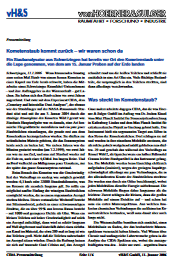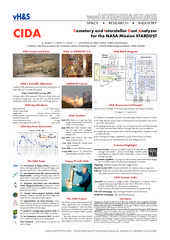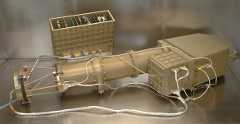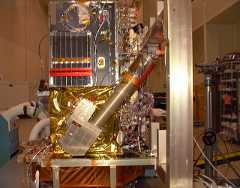CIDA
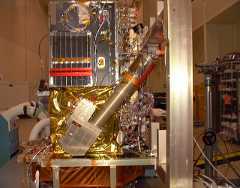
On February 7, 1999 the NASA spacecraft Stardust was successfully launched with the primary goal to analyse dust of volatiles from Comet P/Wild 2 and from interplanetary space and to return samples to Earth – with hardware built by vH&S on board.
The Cometary and Interstellar Dust Analyser (CIDA) mounted on the spacecraft is a time-of-flight mass spectrometer analyzing in-situ the chemical composition of dust by the ions created at the impact of the particles onto a silver target. The impacting particles have velocities of up to 80 km per second and are therefore broken up into ions and molecular fragments during the impact. The high velocity of the particle impacting on the silver target of CIDA, causes the different elements to transform into “ions”, i.e. hydrogen transforms into hydrogen ions. Since ions are “charged” they can be accelerated by high voltage electrical fields and then travel over a certain distance till they hit a detector. The time of this flight is depending on the mass of the individual type of ions: hydrogen is the lightest element (mass 1) and therefore arrives first at the detector. Iron is heavier (mass 56) and therefore arrives later. Thus the time of flight depends on the individual mass, and the measurement of the different times of flight gives therefore the elemental composition of the dust grain that has hit. By this method, CIDA can determine the elemental composition and the original mass of the individual dust grains.This instrument, built by vH&S under contract with DARA, will not only be operated at the flyby at comet Wild 2 in 2004 to analyse cometary dust, but also during certain periods of the cruise phase, in order to analyse interstellar dust grains in real time.
The first measurements by CIDA of interstellar dust particles in April 2000 presented breaking news for the composition of interstellar particles and its understanding of life on our planet. The size of the particles as well as the seeming absence of any minerals constituents surprised scientists. Only organic carbon-based molecules can reach the size measured. This discovery could mean that molecules drifting in space if they got in contact with liquid water on the young Earth could have initiated a chemical reaction which could create the prerequisite for the origin of life. On the other hand, this also indicates the possibility for life on other planets.
CIDA/Stardust was developed and built by vH&S under contract of the German space agency DARA with Dr. Jochen Kissel from the MPE, Munich as Principal Investigator, and Co-Investigators from Germany, the FMI, Helsinki, and the IAS, Orsay. This project had been a real challenge to vH&S because of the short time of not quite two years till delivery. “The successful delivery as the first instrument aboard was a tremendous success and this spread around and was one of the reasons that we got another contract for such a type of instrument from APL for the NASA mission CONTOUR. I think by now we do have quite a reputation for far away extraterrestrial missions and its severe standards!”
Press Releases
Press Material
Here you find various material for immediate and unlimited publishing. To request more info, please write E-Mail to:
- Dr.-Ing. Hartmut Henkel, E-Mail: henkel @ vh-s.de
CIDA Links
Here you find links of our partners:
- http://stardust.jpl.nasa.gov Homepage of the Stardust Mission, Jet Propulsion Laboratory, California Institute of Technology.
- http://www.fmi.fi/research_space/space_31.html The CIDA/Stardust homepage at the Finnish Meteorological Institute.
- http://www.mpe.mpg.de Homepage of the Max-Planck-Institute for Extraterrestrial Physics in Garching.
